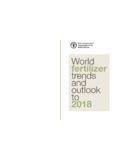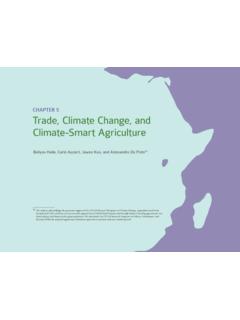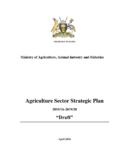Transcription of Adoption of Climate-Smart Agricultural Practices: …
1 Adoption of Climate-Smart Agricultural practices : barriers , incentives , benefits and Lessons Learnt from the MICCA Pilot Site in Kenya FINAL REPORT. Prepared by Morgan C. Mutoko for MICCA Programme FAO. December 2014. 1. 2. TABLE OF CONTENTS. TABLE OF CONTENTS .. 3. LIST OF TABLES .. 4. LIST OF FIGURES .. 5. ACKNOWLEDGEMENTS .. 6. 1 INTRODUCTION .. 7. Overview of the MICCA pilot project in promotion of CSA practices in the pilot site 8. 2 METHODOLOGY AND CONDUCT OF THE STUDY .. 9. The study area .. 9. Survey sampling procedure .. 9. Data collection process .. 10. Focus group discussions .. 10. Data analysis and presentation of 11. 3 RESULTS OF THE STUDY .. 12. Household socio-economics and farm characteristics .. 12. Household type and size .. 12. Education level and main 12. Access to Agricultural markets and credit facilities .. 13. Land ownership, labour availability and farm productivity .. 15. Adoption of Climate-Smart Agricultural practices .. 17. Participation in project activities.
2 17. Improved fodder production .. 19. Agroforestry and fodder trees .. 24. Tree nursery establishment and challenges .. 28. Manure management: composting and biogas use .. 29. Adoption profile of Climate-Smart Agricultural practices .. 30. Adoption constraints, incentives and early benefits .. 32. Constraints to Adoption of Climate-Smart Agricultural practices .. 32. Early benefits of Climate-Smart Agricultural practices .. 34. incentives for Adoption of Climate-Smart Agricultural practices .. 38. 4 DISCUSSION ON barriers TO Adoption AND LESSONS LEARNT 40. Socio-economic and cultural barriers to Adoption of CSA practices .. 40. Policy and institutional frameworks influencing Adoption of CSA 40. Lessons learnt from the implementation of the MICCA pilot project .. 42. 5 CONCLUSIONS AND RECOMMENDATIONS ..43. 6 REFERENCES .. 44. 7 ANNEXES .. 46. Terms of References: Study on barriers and incentives to Adoption of climate - smart Agricultural practices and lessons learnt in the MICCA pilot site.
3 46. Tool (Survey questionnaire) .. 47. Tool (FDG Check Lists) ..58. 3. LIST OF TABLES. Table 2-1: Survey sample size distribution by gender across 6 locations in Kaptumo Division .. 9. Table 2-2: Participants by gender in focused group discussions, Kaptumo Division, Nandi County .. 11. Table 3-1: Education levels attained by farmers .. 12. Table 3-2: Primary occupation of farmers and their main sources of income .. 13. Table 3-3: Common means of transportation, cost and time taken to the nearest market .. 14. Table 3-4: Selected farm characteristics .. 15. Table 3-5: Average productivity and income from the main farm enterprises .. 16. Table 3-6: MICCA pilot project capacity building activities that farmers participated in .. 18. Table 3-7: Most important information accessed through the MICCA pilot project .. 19. Table 3-8: Type of improved fodder crops currently planted on farms .. 19. Table 3-9: Average area under improved fodder production ..20. Table 3-10: Important criteria considered when choosing the type of fodder to plant.
4 22. Table 3-11: Types of agroforestry and fodder trees planted on farms .. 24. Table 3-12: Average tree population planted on the farm by type ..25. Table 3-13: Comparison of average number of trees planted before and after MICCA. intervention ..25. Table 3-14: Challenges faced in the management of tree nurseries .. 28. Table 3-15: Common uses of livestock manure .. 29. Table 3-16: Spearman's rho correlations in adopted Climate-Smart Agricultural practices .. 30. Table 3-17: Statistical relationship between CSA practices Adoption and household socio- economic characteristics .. 31. Table 3-18: Key constraints to Adoption of improved fodder crops .. 32. Table 3-19: Factors that limit the establishment of tree nurseries .. 33. Table 3-20: Main constraints to Adoption of improved manure management practices .. 33. Table 3-21: Key benefits attributed to the use of livestock manure in crop production .. 36. Table 3-22: Most important benefits from the adopted Climate-Smart Agricultural 38.
5 Table 3-23: Necessary incentives for Adoption of Climate-Smart Agricultural practices .. 38. 4. LIST OF FIGURES. Figure : Distribution of farmers who obtained Agricultural credit and main uses of the loan .. 14. Figure : Farmers' participation in capacity building activities promoted by MICCA pilot 17. Figure : Common niches for cultivation of improved fodder crops .. 21. Figure : Main sources of fodder seeds and planting materials .. 21. Figure : Factors influencing the area under improved fodder production ..22. Figure : Main fodder conservation practices .. 23. Figure : Trend in livestock feed scarcity during the past 12 months .. 24. Figure : Common niches for cultivation of agroforestry and fodder trees .. 26. Figure : Main sources of seedlings for agroforestry and fodder trees .. 27. Figure : Criteria considered when choosing the type of agroforestry and fodder trees to plant .. 28. Figure : Livestock manure management practices .. 29. Figure : Perceived contribution of Climate-Smart Agricultural practices to household food security (a) and income (b).
6 35. Figure : benefits from adopted agroforestry and fodder trees .. 36. Figure : Households that did not have sufficient food during the last 12 months .. 37. 5. ACKNOWLEDGEMENTS. The development of the methodology, the survey questionnaire and FGD check list, and the analysis were supported by Janie Rioux from the MICCA team at FAO. Collection of the data presented in this report was made possible by a committed team of six enumerators: Hellen Sang, Emmanuel Serem, Dorcas Jepng tich, Abraham Lagat, Richard Biwot and Robert Tabut. The team worked tirelessly for long hours during field work and we highly appreciate their contribution to the success of this study. We are grateful to the MICCA field project team led by Josephine Kirui, Sylvia Wafula and Moses Ndathie for providing smooth logistical facilitation and facilitating the focus group discussions during field work in Kaptumo Division. The management of Kapcheno Multipurpose Company is also acknowledged for providing local support to the field activities.
7 Finally, we are indebted to the 197 farmers and farmer trainers who freely gave of their time. 6. 1 INTRODUCTION. climate change poses new challenges to the fight against poverty and sustainability of agrarian livelihoods in sub-Saharan Africa. Predictions indicate that climate change will adversely affect Agricultural production in sub-Saharan Africa through declining crop yields and livestock productivity caused by rainfall variability, rising temperatures and increased pest/disease incidences (Kurukulasuriya et al., 2006; Kurukulasuriya and Rosenthal, 2003). More recent findings confirm that climate change is likely to cause considerable crop yield losses thereby adversely affecting smallholder livelihoods in Africa (Lobell et al., 2011). As a result, food security and income generation opportunities for the farming households that are most reliant on agriculture may be in jeopardy. The North-western region of Kenya is a major producer of food crops and livestock products in the country (Government of Kenya, 2005).
8 This means that major changes in productivity of key Agricultural enterprises from the effects of climate change may lead to far-reaching implications on national food security and farmers' livelihoods. Therefore, the current challenge faced by Agricultural policy-makers, researchers and extension workers in Kenya is how to design policies, generate and disseminate technologies and information that will offer greater resilience to the Agricultural production system under changing climatic conditions. In the first part of the decade, efforts have been made by different national and international institutions to enhance farmers' resilience to climatic risks and mitigate climate change in agriculture. For example, the FAO's Mitigation of climate Change in Agriculture (MICCA) programme with a pilot project in Kaptumo, Nandi County. This study is part of the MICCA pilot project in Kenya. The main aim of the MICCA programme is to support developing countries in their efforts to mitigate climate change in agriculture.
9 The programme focusses on gradual transformation of Agricultural productivity through implementation of Climate-Smart Agricultural policies and practices (FAO, 2012). The MICCA programme envisages that successful promotion of such policies and practices would occur within the context of sustainable management of land, water and genetic resources to improve farmers' responsiveness to climate change challenges affecting agriculture, livelihoods and poverty alleviation. Climate-Smart agriculture (CSA) as defined by FAO comprises of three main pillars: 1) sustainably increasing Agricultural productivity and incomes, 2) adapting and building resilience to climate change, and 3) reducing and/or removing greenhouse gases emissions, where possible. CSA is designed to implement sustainable Agricultural development while addressing the food security and climate change challenges. In this regard, two MICCA pilot projects have been implemented in Kenya and Tanzania for the past three years.
10 In Kenya, the MICCA pilot project, which was initiated in September 2011, mainly focussed on smallholder dairy farmers, with the aim of integrating Climate-Smart practices into the farming system and improving productivity. To achieve this, the MICCA pilot project co- operated with the East African Dairy Development (EADD) project to promote a variety of 7. CSA practices including agroforestry, improved fodder production, tree nurseries, manure management, composting and biogas generation (FAO, 2012). This study examines the incentives and constraints to Adoption of the promoted climate - smart Agricultural practices in Kaptumo, Nandi County of Kenya. Findings and insights from this study provides useful knowledge on the dynamics of Adoption of the CSA practices and lessons learnt to further inform extension, projects and up-scaling. The results from this study are valid for the population in the MICCA pilot site and may be generalized to similar areas in Nandi County and other counties in the country, which are characterized by tea- maize-dairy farming system and small land sizes.















